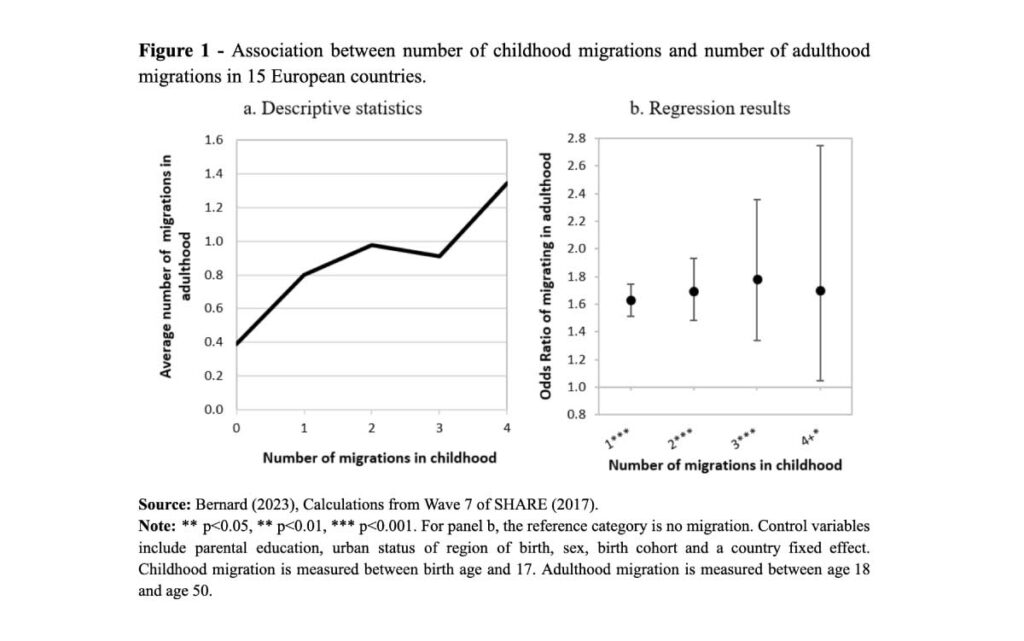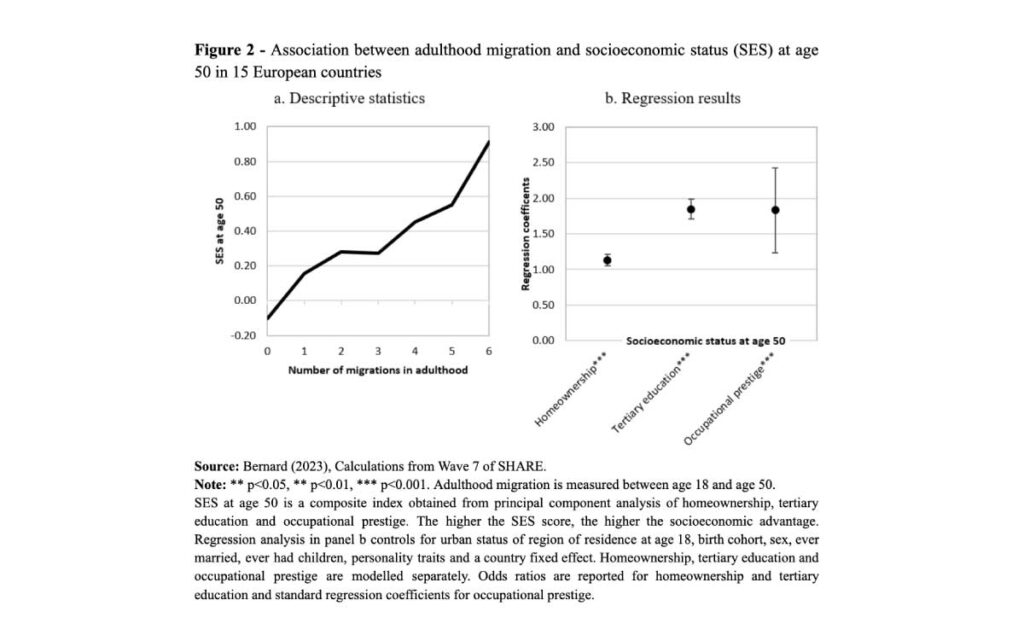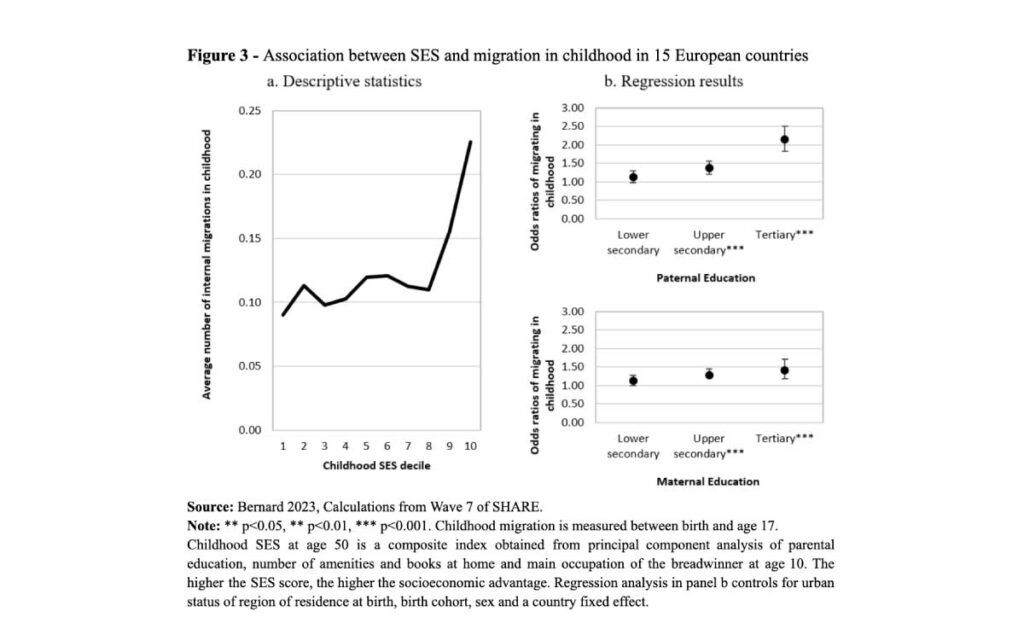Using lifetime data for baby boomers from 15 European countries, Aude Bernard shows that (i) children from higher socioeconomic backgrounds are more likely to migrate and (ii) individuals who migrated in childhood are more likely to migrate in adulthood. Thus, poorer children are doubly disadvantaged in coming from a lower socioeconomic background and being less migratory, which limits the economic benefits of changing region of residence in adulthood and exacerbates social reproduction.
The widening of income inequalities has stimulated research on the intergenerational transmission of advantage and disadvantage. We now know that social reproduction is a multidimensional process underpinned by various mechanisms, including parental time and resource investments, parental socialisation, wealth assortative mating and neighbourhood effects. Internal migration may be an additional mechanism.
In a recent paper, I used retrospective data from the Survey of Health and Ageing in Europe (SHARE), which, at Wave 7 in 2017, collected complete migration histories from birth to age 50 in 15 European countries: Austria, Belgium, Croatia, the Czech Republic, Denmark, Estonia, France, Germany, Greece, Italy, Luxembourg, Slovenia, Spain, Sweden, and Switzerland (Bernard 2023). I defined migration as a change of NUTS-2 region (i.e., regions in France, Hungary, and Italy; provinces in Belgium; national areas in Sweden; and autonomous communities in Spain), which means that I focused on relatively long-distance internal migration and on its role in the perpetuation of socioeconomic inequalities
Migration is intergenerationally transmitted
Mounting evidence indicates that migration is transmitted from parents to children (Bernard and Vidal 2020; Myers 1999): individuals who migrated in childhood and adolescence (0‒17 years) are more likely to migrate throughout adulthood (18‒50 years). By leaving and entering new social contexts, children are likely to develop social skills that they can mobilise for future migration. Panel a in Figure 1 shows a clear linear association between the number of childhood internal migrations and the number of adulthood migrations. Individuals who did not migrate in childhood report an average of 0.40 migrations in adulthood, compared with one or more migrations among individuals who migrated at least twice in childhood. This association holds when parental socioeconomic background is controlled, as in Panel b.

This finding supports the idea that internal migration is intergenerationally transmitted. More importantly, panel b shows that migrating at least once in childhood is paramount to increasing the odds of migrating in adulthood. The overlapping confidence intervals imply that the number of childhood migrations is not relevant to subsequent migration decisions in adulthood.
Migration is socioeconomically beneficial
Children who migrated in childhood are more likely to reside in large cities which provide greater educational and employment opportunities. Considering sociospatial inequalities, this means that childhood migration can promote upward social mobility without the need to migrate in adulthood. However, individuals who migrated in childhood are more likely to migrate in adulthood than stayers even if they reside in large cities (results not reported here).
This is important because internal migration in adulthood promotes upward occupational mobility (Fielding 1992; Mulder and Van Ham 2005). Panel a in Figure 2 depicts a positive linear association between the number of adulthood internal migrations and SES at age 50: individuals who migrate in adulthood multiple times are more likely to report higher SES at age 50. Regression coefficients in panel b confirm this association when controlling for possible cofounders. Migrating in adulthood promotes all three components of SES: homeownership, tertiary education and higher occupational prestige. The effect of migration on the latter two is particularly pronounced for migration to large urban centres (Results not reported here).

Migration is selective
The results so far mean that individuals exposed to internal migration early in life are more likely to migrate in adulthood and thus more likely to report a higher socioeconomic status at age 50. This finding has important implications for understanding social mobility and social reproduction. On the one hand, internal migration could be an important mechanism for individuals to achieve intergenerational upward social mobility. On the other hand, because migration likelihood increases with educational level (Wagner 1990) and because this relationship is nearly universal (Abel and Muttarak 2017), children from lower socioeconomic backgrounds are less likely to migrate than children from higher socioeconomic backgrounds.
Panel a of Figure 3 shows that European children from the top two deciles report more than twice as many internal migrations, on average, as children from the lower deciles, suggesting that the propensity to migrate internally in childhood is socially determined.

This association holds when country, birth cohort and sex are controlled for in panel b: the higher the level of parental education, the greater the odds of migrating in childhood. The effect of education is gradual and holds for both paternal and maternal education.
Implications
Collectively, my results show that European children from lower socioeconomic backgrounds are doubly disadvantaged in having a disadvantaged background and being less migratory, which exacerbates social reproduction by limiting their mobility in adulthood and the economic benefits of changing region of residence.
The relevance of the processes described here for international migration deserves to be explored. Growing evidence suggests that international migration is also transmitted intergenerationally (de Jong and de Valk 2023). A continued increase in cross-country migration within Europe points to the importance of understanding its potential role in the transmission of inequalities between generations.
References
Abel, G. and R. Muttarak. 2017. “Who is moving? Exploring internal migration by gender and occupation across 58 countries.” in IUSSP conference. Cape Town, South Africa.
Bernard, A. 2023. “Does Internal Migration Contribute to the Intergenerational Transmission of Socioeconomic Inequalities? The Role of Childhood Migration.” Demography: 10826486-10826486.
Bernard, A. and S. Vidal. 2020. “Does moving in childhood and adolescence affect residential mobility in adulthood? An analysis of long-term individual residential trajectories in 11 European countries.” Population, Space and Place 26(1): 1-16.
de Jong, P.W. and H.A. de Valk. 2023. “Emigration of the Western European second generation: is having immigrant parents a predictor of international migration?” Journal of Ethnic and Migration Studies: 1-22.
Fielding, A.J. 1992. “Migration and social mobility: South East England as an escalator region.” Regional Studies 26(1): 1-15.
Mulder, C.H. and M. Van Ham. 2005. “Migration histories and occupational achievement.” Population, Space and Place 11(3): 173-186.
Myers, S.M. 1999. “Residential mobility as a way of life: Evidence of intergenerational similarities.” Journal of Marriage and the Family 61: 871-880.
Wagner, M. 1990. “Education and migration.” in Event History Analysis in the Life Course Research, edited by K.U. Mayer and N.B. Tuma. Madison: The University of Madison.


